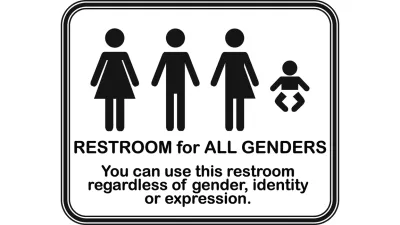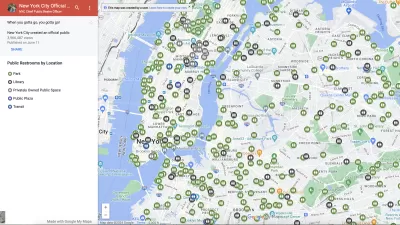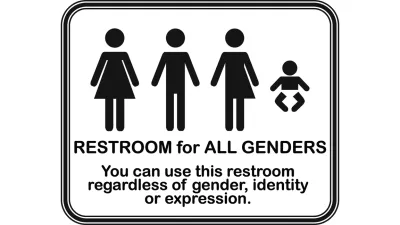There are several reasons that gender neutral bathrooms will soon replace separated men's and women's bathrooms, and they have nothing to do with gender identity, explains Jimmy Parker, event producer and former BID director.

Gender neutral bathrooms are just better. It has nothing to do with gender identity or current affairs. There are several reasons that gender neutral bathrooms will soon replace separate men's and women's bathrooms, explains event producer and the long time president of San Diego's Gaslamp Quarter Association—a Businsess Improvement District. A few of the reasons include:
Benefits
Once you begin to design standardized approaches to public restroom facilities, certain benefits will be realized. Here are a few:
- No need to calculate use based on demographics.
- No duplication of hand wash stations, signage, lighting, and general access corridors
- Easier family use (Fathers with daughters, Mother with sons)
- Easier calculation/conformance with ADA standards
Safety
This area seems to be where the greatest passion exists on both sides of the political debate, but I would ask the reader to consider the following:
- Unisex restrooms (shared areas) are easier to patrol with security personnel. With separate facilities, sex-specific guards need to be available to respond to emergencies/concerns.
- Greater traffic increases safety. The potential of swifter response to inappropriate behavior is a great deterrent.
- Children can be accompanied by both parents/grandparents. Especially important with multiple children.
- Stalls, unlike urinal dividers, can be re-enforced to provide better (not complete) protection when people need to shelter in place during violent incidents.
Parker concludes by asking planners and municipalities to remove remove regulatory obstacles to their implementation and to develop standards to allow all large scales public projects to have gender neutral bathroom facilities.
FULL STORY: A Planner’s Opportunity – Gender Neutral Facilities

Americans May Be Stuck — But Why?
Americans are moving a lot less than they once did, and that is a problem. While Yoni Applebaum, in his highly-publicized article Stuck, gets the reasons badly wrong, it's still important to ask: why are we moving so much less than before?

Using Old Oil and Gas Wells for Green Energy Storage
Penn State researchers have found that repurposing abandoned oil and gas wells for geothermal-assisted compressed-air energy storage can boost efficiency, reduce environmental risks, and support clean energy and job transitions.

Placekeeping: Setting a New Precedent for City Planners
How a preservation-based approach to redevelopment and urban design can prevent displacement and honor legacy communities.

San Francisco’s Muni Ridership Grew in 2024
The system saw its highest ridership since before the Covid-19 pandemic, but faces a severe budget shortage in the coming year.

Colorado Lawmakers Move to Protect BRT Funding
In the face of potential federal funding cuts, CDOT leaders reasserted their commitment to planned bus rapid transit projects.

Safe Streets Funding in Jeopardy
The Trump administration is specifically targeting bike infrastructure and other road safety projects in its funding cuts.
Urban Design for Planners 1: Software Tools
This six-course series explores essential urban design concepts using open source software and equips planners with the tools they need to participate fully in the urban design process.
Planning for Universal Design
Learn the tools for implementing Universal Design in planning regulations.
Heyer Gruel & Associates PA
City of Moreno Valley
Institute for Housing and Urban Development Studies (IHS)
City of Grandview
Harvard GSD Executive Education
Salt Lake City
NYU Wagner Graduate School of Public Service
City of Cambridge, Maryland




























